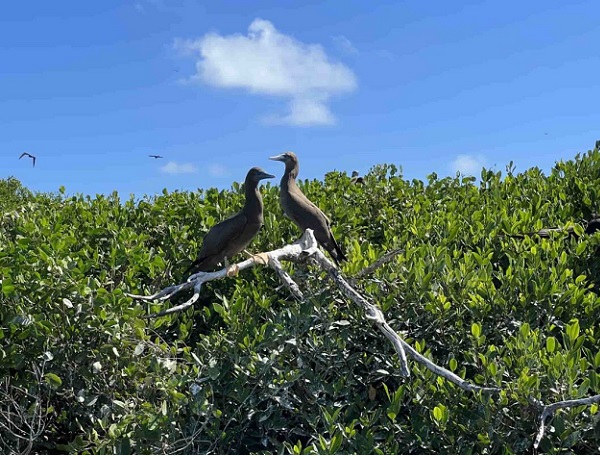
WIC News zooms in on five Caribbean escapes to wildlife reserves in Antigua and Barbuda, Belize, Grenada, Guyana, and Trinidad and Tobago.
The Caribbean region is full of awe-inspiring reserves that allow natural ecosystems to thrive. Whether hiking, diving, wildlife watching, or just sitting quietly, the region is full of locations which are perfect for vacations with family or friends.
People from around the world travel to the small island nations in the Caribbean to spend their holidays. These islands include Antigua and Barbuda, Guyana, Grenada and several others. Here are five escapes for traveller’s bucket list for Summer 2024:
Codrington Lagoon – Antigua and Barbuda
Barbuda’s 62 square miles of coral limestone slope from low, gentle hills near the east coast to the mangrove wetlands of the Codrington Lagoon in the west. Protected as a national park, the lagoon is home to the Frigate Bird Sanctuary, which hosts the world’s largest population of these impressive seabirds – an estimated 10,000.
One of the many caves nearby – Indian Cave – also boasts bats, crabs, iguanas, tropicbirds and petroglyphs from the First Peoples.
Shell Beach Protected Area – Guyana
Near Guyana’s northernmost point, past the mouth of the Pomeroon River, a 90-mile stretch of untouched coast is the annual nesting ground for endangered sea turtles.
The beach is made up of countless seashells pulverised to sand: perfect terrain for turtles to lay their eggs in excavated nests. Backed by mangrove forests and ité palms, the region is also famed for its diversity of bird species – from scarlet ibis to kingfishers, spoonbills to flamingos. Visits to this unspoilt remote region and its extraordinary natural surroundings are organised via the Guyana Marine Turtle Conservation Society.
Main Ridge Forest Reserve – Trinidad and Tobago
Tobago’s 18-mile-long Main Ridge is home to the Main Ridge Forest Reserve – the oldest protected rainforest in the western hemisphere and a landmark in global conservation. In the early 18th century. Scientist Stephen Hales convinced the island’s plantation owners that cutting down the forest would destroy the balance of nature and reduce the island to a barren desert.
Through a royal ordinance in April 1776, some 14,000 acres were designated as a protected Crown Reserve “for the purpose of attracting frequent showers of rain upon which the fertility of lands in these climates doth entirely depend.” It was “the first act in the modern environmental movement”, according to Scientific American, benefiting and delighting Tobago’s citizens and visitors alike to this day.
Grand Etang National Park and Forest Reserve – Grenada
Visitors can find lush mountains, crystal-clear rivers, diverse avifauna as well as awe-inspiring waterfalls in the oldest and largest protected area in Grenada. Translated from French, “Grand Etang” means “large lake”, and, at the heart of this 3,816-acre national park, Grand Etang Lake occupies the 36-acre crater of an extinct volcano.
The reserve is home to countless species of wildlife, including the mona monkey (Cerco-pithecus mona def), which was transported to Grenada from West Africa in the 18th century.
Cockscomb Basin Wildlife Sanctuary – Belize
Belize is home to many fascinating protected areas: bird sanctuaries, natural monuments, national parks, marine and forest reserves — including the world’s first jaguar preserve in the Cockscomb Basin Wildlife Sanctuary.
Enjoy sightings of agouti, 300 bird species, monkeys, and snakes, or discover an inconspicuous Mayan ceremonial site, hiking trails, creeks and streams (all good sources for adventure).
For original post and photos, see https://wicnews.com/caribbean/know-5-escapes-in-caribbean-for-your-summer-2024-vacation-533765751/
[Shown above: Codrington Lagoon – Antigua and Barbuda (PC – Facebook).]
WIC News zooms in on five Caribbean escapes to wildlife reserves in Antigua and Barbuda, Belize, Grenada, Guyana, and Trinidad and Tobago. The Caribbean region is full of awe-inspiring reserves that allow natural ecosystems to thrive. Whether hiking, diving, wildlife watching, or just sitting quietly, the region is full of locations which are perfect for







